As we
reported earlier, the engine of the F10 M5 isn't a direct swap from the X5 M and X6 M but a substantially revised engine. In an interview with
M-Power.com, Jürgen Poggel, Head of Engine Development at BMW M GmbH, now shared more details on this engine. Read the full interview below to learn more about the newly introduced VALVETRONIC, the principle of the cross bank exhaust manifold and more. An interesting tidbit: Unlike earlier M engines, the S63TU no longer needs 10W-60 oil.
Mr Poggel, what were the greatest challenges in developing the V8 engine for the new BMW M5?
Jürgen Poggel: The V8 engine is a high performance sports engine. Our goal in developing this new model was to make it even better that the V10 engine of the predecessor, which had already gained legendary status.
Where do you see the advantages?
One key advantage of this turbo engine is the high torque available from speeds as low as the bottom range. Whereas I have to use the right gear with the matching speed for the V10, the new engine with M TwinPower Turbo technology delivers unbridled thrust over a wide speed range. The new motor provides nearly 700 Nm of torque at a speed as low as 1500 rpm. In the V10, this was about 300 Nm. The characteristics of the high speed turbo unit with its extremely spontaneous response make the V8 in the new BMW M5 the ultimate sports engine.
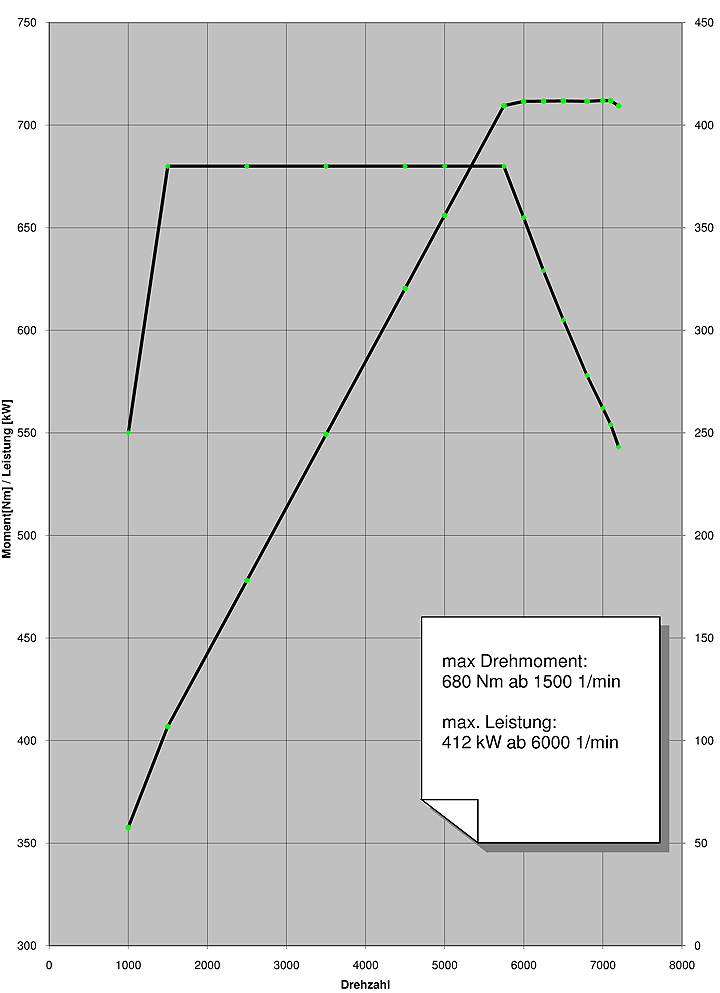 Power and torque curves of the new BMW M5 engine.
What does that mean?
Power and torque curves of the new BMW M5 engine.
What does that mean?
In many turbo engines, power output soon drops with rising speed. The output from this engine, on the other hand, remains constant from 1000 rpm. So rev limits make sense. And we have implemented a large number of technical measures that raise the response to the level of an aspirated engine.
What does the customer get from all this?
He gets outstanding performance and drivability on both the race track and public roads.
On the race track I have to shift gears less. The sensitive response allows me to balance the vehicle with the accelerator pedal over a wide speed range. This means faster lap times.
In everyday situations, the most convincing feature is above all the superior performance potential. The engine builds up a huge thrust, mostly over more than one gear. And we have raised the efficiency of the engine, so that it now needs considerably less fuel – both on paper and in reality. This benefits above all the range – in addition to your purse and the environment, a clear advantage over the predecessor.
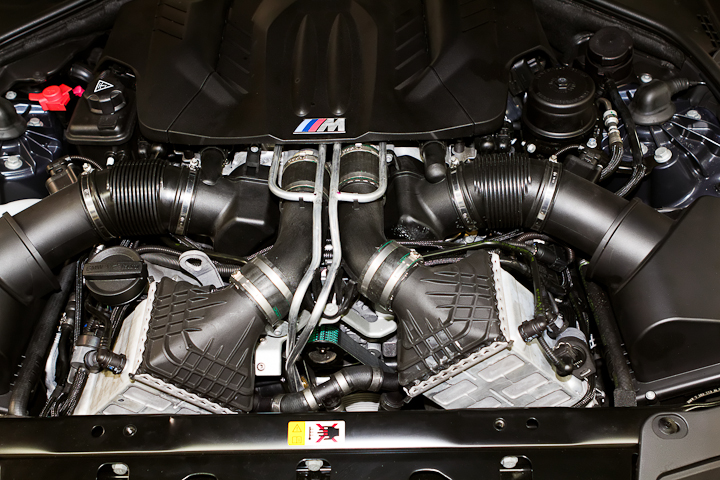 The V8 engine of the new BMW M5. Seen at the front are the two charge air coolers, and further out the two intake silencers.
How did you achieve this combination of properties, which is almost like trying to square the circle?
The V8 engine of the new BMW M5. Seen at the front are the two charge air coolers, and further out the two intake silencers.
How did you achieve this combination of properties, which is almost like trying to square the circle?
The magic word here is dethrottling. Dethrottling means improving the response, the power output, and the efficiency. We modified practically everything in the air intake and exhaust system.
 Generously dimensioned pipes in the intake section.
Let’s start with the intake.
Generously dimensioned pipes in the intake section.
Let’s start with the intake.
The charge air exiting the compressor measures as much as 130 °C and must be cooled. In this engine, the charge air is not cooled with air, but indirectly with water. So I don’t need to transfer the air through long pipes, and the throttle losses are very much lower. We use coolers and pipe cross sections of exceptionally generous sizes. Intake silencers and charge air coolers are installed very close to the engine. All of these measures contribute to dethrottling on the intake side.
Low temperature circuit for cooling the charge air and the Digital Motor Electronics:
A Coolant radiator
B Additional coolant radiator
C Electric coolant pump for cylinder bank 1
D Charge air cooler for cylinder bank 1
E Expansion tank
F DME cylinder bank 1
G DME cylinder bank 2
H Charge air cooler for cylinder bank 2
I Electric coolant pump for cylinder bank 2
J Additional coolant radiator
The V8 engine of the new BMW M5 is now also fitted with “VALVETRONIC”. Can you tell us what that means?
With the VALVETRONIC, the intake valve lift can be varied continuously from two or three tenths of a millimetre to the max limit. The advantage of this is best seen when compared with the conventional aspirated engine. In this latter case, the power is regulated via the so called throttle valve. The engine always tries to take in the full quantity of air, but I’m just not letting it. The valve is open fully only at full throttle. When I close the throttle gap, the engine generates a partial vacuum throughout the intake system. When the intake valve is closed and the piston starts moving up, this partial vacuum can no longer be used for the engine.
Continuous valve lift adjust for throttle-free load control.
01 VANOS adjust unit on exhaust side
02 Exhaust camshaft
03 Roller cam follower
04 Hydraulic valve adjuster HVA
05 Valve spring on exhaust side
06 Exhaust valve
07 Intake valve
08 Hydraulic valve adjuster HVA
09 Valve spring on intake side
10 Roller cam follower
11 VALVETRONIC servomotor
12 Eccentric shaft
13 Spring
14 Intermediate lever
15 Intake camshaft
16 VANOS adjust unit on intake side
With VALVETRONIC, the quantity of air is regulated at the valve. When the cylinder has enough air for the respective load point, I close the valve. A partial vacuum is therefore generated here as well when the piston moves down. As an analogy, imagine closing the hole in the end of a bicycle pump while you’re pulling on the other end: let go, and the end returns inside the pump. In other words, the energy I expend building up the partial vacuum I can get back afterwards. The throttle losses are therefore reduced.
VALVETRONIC also allows the charging pressure to build up considerably faster. We can therefore use a load control that lets me keep the turbine at speed and open the valve clearance as much as I need when shifting gears or accelerating. When I step on the accelerator, I feel the thrust pressing into me faster, and there is far better response.
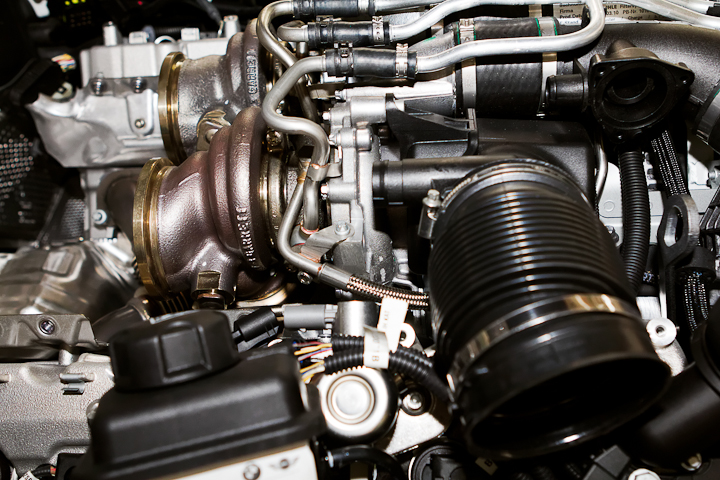 Engine with removed catalytic converters and intake silencers.
And on the exhaust side? We’re constantly hearing about “cross bank exhaust manifold” and “twin scroll twin turbo technology” without actually understanding the advantages.
Engine with removed catalytic converters and intake silencers.
And on the exhaust side? We’re constantly hearing about “cross bank exhaust manifold” and “twin scroll twin turbo technology” without actually understanding the advantages.
(Laughs.) The cross bank exhaust manifold is an optimised collector of exhaust gases for the turbocharger from each of the cylinders. The V8 engine runs with a stutter anyway, giving rise to the typical V8 bubbling. A twelve cylinder always ignites the cylinders in the bank in crosswise fashion, one left, one right, nice and regular. For reasons of comfort, the V8 is fitted with a crankshaft that ignites twice in succession on the one bank and then jumps to the other. You can hear this highly irregular ignition sequence as the typical V8 bubbling in the exhaust tract, a sound you cannot hear from the engine of the new BMW M5.
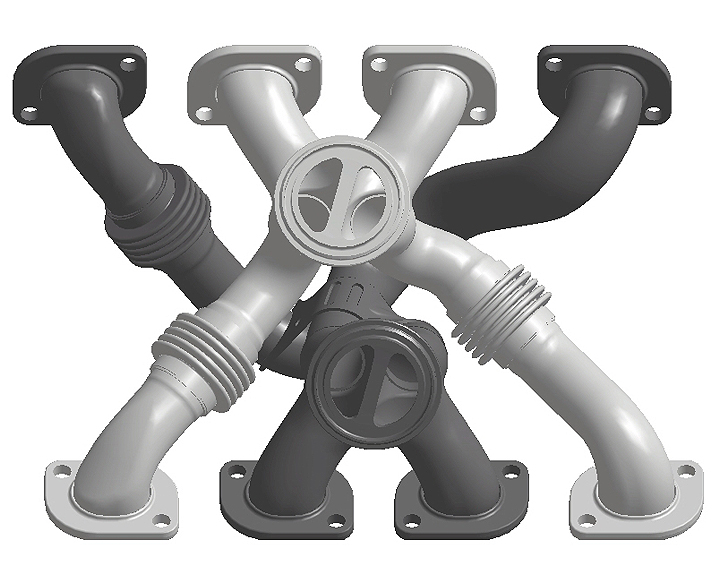 Principle of the cross bank exhaust manifold.
Principle of the cross bank exhaust manifold.
The cross bank exhaust manifold is made up of pipes that are joined to both banks in a rigid structure. The exhaust gases are therefore transferred optimally to the turbochargers. Every cylinder can therefore “expirate” under the optimal conditions. When I open the exhaust valve, a very hot, high energy jet of exhaust gases is released under a high pressure that hits an exhaust gas duct and then the charger turbine with virtually undiminished force. I therefore utilise the energy not only in the exhaust gas flow, but also in its momentum. As an analogy, imagine blowing on a pinwheel with a single breath: you’ll see that not only the volume, but also the momentum of the air has an effect.
 Cross bank exhaust manifold with M TwinPower Twin Scroll turbochargers.
Cross bank exhaust manifold with M TwinPower Twin Scroll turbochargers.
This works only because the Twin Scroll turbines separate the exhaust gas flows in the two turbo chargers.
To illustrate this advantage, let’s try the following thought experiment. Let us imagine a very simple setup. Eight cylinders blow through a “hole” on an exhaust gas turbine. The pressure pulse therefore not only hits the turbine, but also spreads into other exhaust gas pipes. I therefore lose energy. This method is called constant-pressure turbocharging: I pump everything together into a large vessel from which the collected exhaust gas passes over the turbine. In our two turbos, however, the Twin Scroll ducts act as a partition in the turbine, so that every exhaust pulse hits the turbine blades directly without getting lost on the way. This is how we can utilise the speed of the gas as well. Not only the volume of the exhaust gas jet, also its dynamics takes effect – and its momentum is converted effectively.
This transfer of exhaust gases offers yet another advantage: when more than one cylinder blows together in a pipe, there is a lot of residual gas there. Consequently, when the exhaust valve is opened, the cylinder cannot fully discharge its exhaust gas. In our motor, the gas flowing out of the cylinder also takes this residual gas with it.
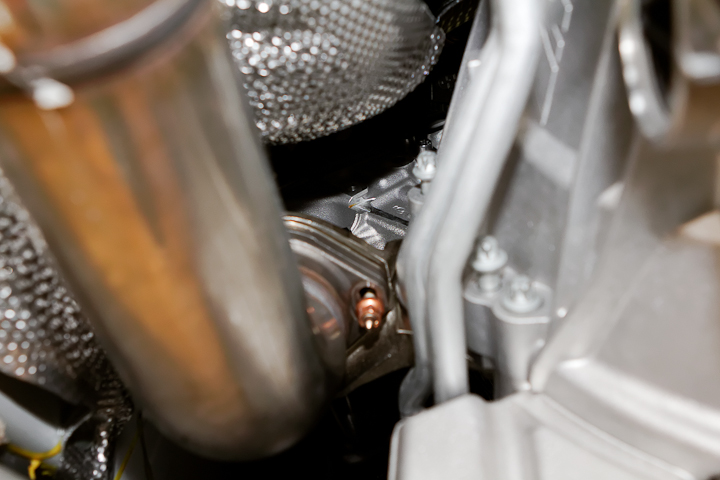 Generously dimensioned pipes exhaust section.
Generously dimensioned pipes exhaust section.
So we have exploited everything we could on the exhaust gas side as well for better charge changing and therefore the optimal response: large pipe cross sections, cross bank exhaust manifold, and twin scroll twin turbo technology.
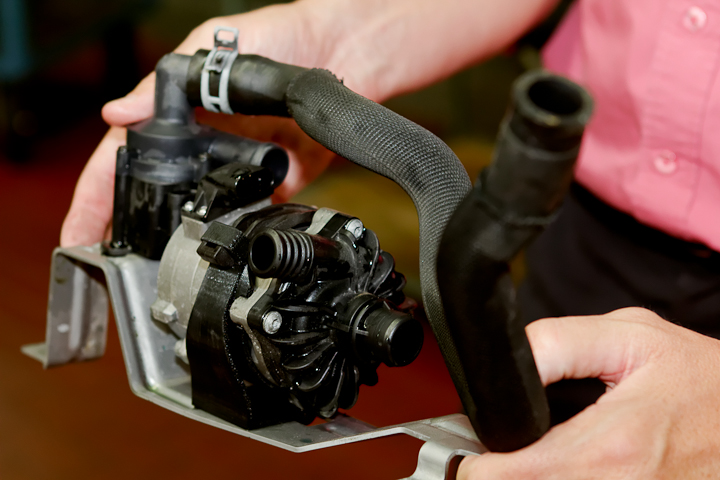 Electric water pump for the low temperature cooling circuit.
Dethrottling the engine offers advantages not only in the form of outstanding response, but also for consumption?
Electric water pump for the low temperature cooling circuit.
Dethrottling the engine offers advantages not only in the form of outstanding response, but also for consumption?
Yes, the engine of the new BMW M5 fulfils nearly all map ranges without fuel enrichment, and therefore higher fuel consumption. All in all, the measures I have described, together with other steps, lead to a huge reduction in consumption during approval procedures and as experienced by customers. This serves to extend above all the range – a benefit that our customers have wished emphatically in the past. Today, our engineers can travel from Garching to the Nürburgring on a single tank of fuel. Earlier, this was just a pipe dream.
 Exhaust side turbocharger with waste gate.
By selecting the Sport or Sport plus accelerator mode, we can really feel the additional boost to the response. How does that work?
Exhaust side turbocharger with waste gate.
By selecting the Sport or Sport plus accelerator mode, we can really feel the additional boost to the response. How does that work?
In Sport or Sport plus mode, a suitable VALVETRONIC controller and the waste gates keep the turbocharger in the higher speed range. Normally, the waste gate used to regulate the charging pressure opens so that the exhaust gas flows out with the minimum possible loss. Pressure is built up again only when I hit the accelerator. For an improved response, I leave the waste gate closed until I need it for regulating. The exhaust gas then always passes over the turbine, which then runs at a considerably higher speed. When even more power is demanded, it is immediately available. However, I have a gradually rising counterpressure that causes a slight rise in consumption. This function can therefore be switched on and off. By the way, in the BMW 1 Series M Coupé the same function is activated at the M Button.
 Engine with cover plate removed. At the back in the centre the two catalytic converters, and next to them the water cooled engine controllers.
We sometimes hear that turbo engines are preferred because they are easier to build. Is that true?
Engine with cover plate removed. At the back in the centre the two catalytic converters, and next to them the water cooled engine controllers.
We sometimes hear that turbo engines are preferred because they are easier to build. Is that true?
No, at least not our engines, not by a long chalk. High speed aspirated engines are subjected to high mechanical forces, and I need charge changing that works not only at the highest speeds, but also with adequate efficiency in normal driving mode.
Furthermore, the turbo engine must fulfil high thermal requirements. The V8 engine of the BMW M5 can run with exhaust temperatures up to 1050 °C. The higher the possible temperatures, the better: I don’t need to enrich the mixture – and raise fuel consumption – for cooling the engine, and high temperatures are good for the response. These temperatures, though, must be mastered and controlled. The engine block of about 200 kg measures at least 110–115 °C, and the temperatures of the exhaust manifolds and turbochargers can be as high as 1000 °C.
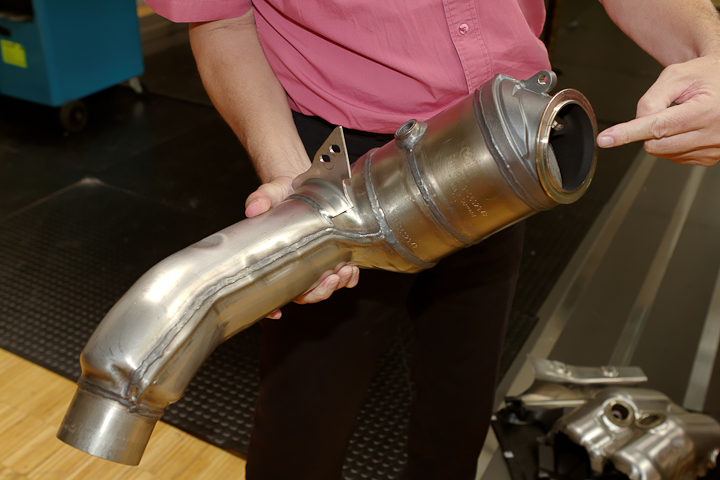 Removed catalytic converter.
Removed catalytic converter.
These must be contained and controlled both in the moving car and after the engine has been switched off. On top, the engine can provide a great deal of power at low speeds too (as I said before: about twice as much as the old V10), so considerably more heat can accumulate there as well. For most cars, this is scarcely of any significance because the full power output is brought to bear only very rarely, if ever. Yet the BMW M5 is a sports car, and this power is demanded, especially on the race track.
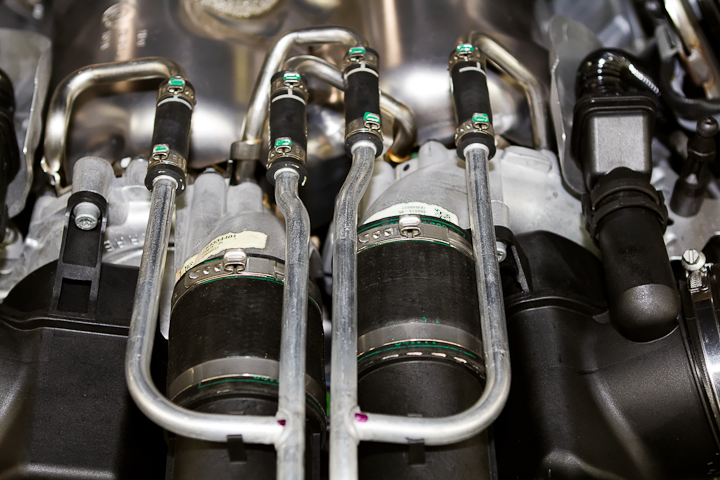 Water cooling for the turbochargers.
How do you safeguard the optimal cooling?
Water cooling for the turbochargers.
How do you safeguard the optimal cooling?
With the most diverse measures. The engine was lowered by two centimetres for enhanced air intake – a measure that of course also lowered the centre of gravity for even greater dynamic effect. In addition, the oil circuit is designed for racing and can therefore take lateral accelerations that can be as high as 1.3 g. Like the brake fluid, the oil should be taken from wherever it is at the time.
 Oil cooler at the bottom of the engine compartment.
Oil cooler at the bottom of the engine compartment.
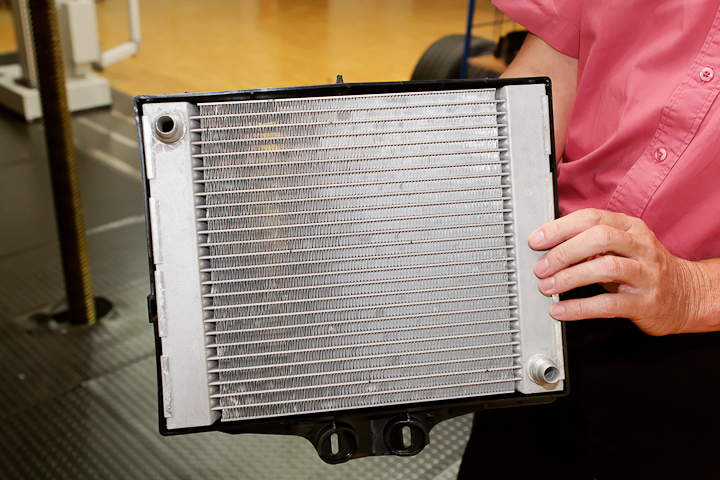 One of three radiators for the low temperature water circuit.
One of three radiators for the low temperature water circuit.
The new BMW M5 has several cooling circuits: the classical cooling water and oil circuits for the engine are joined by a low temperature water cooling circuit that e.g. cools indirectly the charge air cooler. By the way, even the high performance engine controllers are water cooled. And in addition there are other separate cooling circuits for manual gearboxes, etc.
 Water cooled engine controller.
As early as the BMW 1 Series M Coupé, the question was raised as to the max oil temperatures the engine can actually take.
Water cooled engine controller.
As early as the BMW 1 Series M Coupé, the question was raised as to the max oil temperatures the engine can actually take.
The answer is as simple as it may sound surprising: There’s nothing to worry about! Our so called heat manager can detect all critical situations during normal operations. Should any medium, oil, water, or an engine component become too hot under specific environmental or load profiles, countermeasures are taken automatically. These can even involve throttling the power output for the protection of the engine. And when we assume the extreme: there is no cooling for full throttle driving in first gear under a noon desert sun, which is rather silly anyway.
 Instrument dials of the new BMW M5.
Instrument dials of the new BMW M5.
But to get back to the original question: the usual oils can withstand 150 °C well, but it starts getting critical after 160 °C, although 200 °C is occasionally reached on the cylinder liners. These temperatures, though, are only brief and so are not detrimental to the oil. When, on the other hand, the oil is subjected to high temperatures for long and frequent periods, the displayed service intervals automatically take this into account. The high performance M engines are therefore designed for drivers who don’t want to drive with one eye constantly on the oil temperature gauge.
By the way, the engine no longer needs the familiar 10W-60 oil with its high viscosity. Instead, we can use the latest low viscosity oils for considerably less friction.
 So what are you particularly proud of in the new BMW M5?
So what are you particularly proud of in the new BMW M5?
The new BMW M5 delivers a performance that goes right off the scale. You’ll experience an unbelievable range of supreme sporty characteristics. The new BMW M5 is fun on both the race track and the road home. It’s a real pleasure to me every time to drive the new M5.